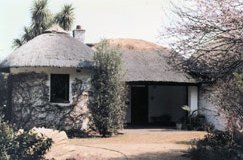Cultural experiences
Gandhi and the house of peace
Legacy
"Also, there is no place in the world where the legacy of Gandhi is conserved in this way," he stresses. "Here, guests can live life the way Gandhi wanted to live – a simple life. The guesthouse will be adapted to his principles." Dabouineau explains that the house will be divided into several parts: new portions will be built where guests will be able to spend the night "in a very specific ambiance". There will be a museum dedicated to Gandhi, to satyagraha and to South Africa. In all, there will be eight rooms on the property, as well as a meditation garden and a spiritually oriented library. Vegetarian food will be served. In keeping with Gandhi's call for simplicity, there will be no wifi, no television, no pool – in fact, no entertainment at all will be provided, "except the privilege of walking and living in Gandhi's path". For those who simply can't live without modern communication, Bayeye adds: "If a guest has a laptop and a 3G stick, then he can use it in his room. But not in the rest of the house or garden." Furniture will be adapted to the time. While it won't be the originals, help has been sought from antique specialists to ensure the furnishings will be based on the early 20th century. It will be comfortable, Bayeye says, but not modern luxury. Building began at the beginning of September, with completion expected in about six months. It is scheduled to open before the end of April 2011. One portion of the original house will be dedicated to an exhibition space, a library and a meditation space, Bayeye explains. There are also three rooms already here.Additions
The main structures being added outside are cottages, which will add three more bedrooms, and a kitchen. There is already a cottage with two rooms. This will be a family suite, while all the rooms will be en suite. It will not be self-catering, rather working on a bed and breakfast principle. Bosman, who is a heritage specialist with an architectural background, says the original house will not be changed, except to undo the alterations made subsequent to Gandhi's leaving. For example, the dormer windows that were added will be restored to the originals. "It is a restoration," he says, rather than a renovation. The new architecture of the outside rooms is completely understated. There is no decoration on the contemporary buildings. "They are very different from the rondavels. They are very plain, very modernist, so that you can see clearly the original," Bosman stresses. "It is important to be able to read history."Museum
The museum is being designed and curated by local specialists, including Itzkin, who curated the permanent exhibition, Johannesburg: birthplace of Satyagraha, at Museum Africa; and Segal, who curated the exhibitions, 466/64 – A Prisoner in the Garden for the Mandela Foundation and Gandhi: A Prisoner of Conscience at Constitution Hill, among other major projects. The two are working closely on the development, and Dabouineau says Itzkin is "consulted on any decision made". Segal explains that the exhibition will be a much more intimate portrait of Gandhi and Kallenbach and their relationship. It will differ from the Constitution Hill exhibition, which focuses on Gandhi's prison years. "It was a very seminal period in both their lives," she explains. "There were deep changes in their lives at the time, in diet, in politics, spiritually." She will also focus on the influence of Tolstoy, the Russian writer, on the two men. It was during this time that they founded Tolstoy Farm, in the south of Johannesburg, to put these principles into practice. Artefacts are expected to come from the Kallenbach family in Israel. The architect moved to Israel after the end of the Second World War, taking with him many of the tools he had made in South Africa, his letters and diaries. "It is these precious things that we are hoping to return to South Africa," Segal says. The script for the museum is being written in the next few months, when more specific detail will emerge. With support from the Indian consul-general and various groups in India, the company believes the guesthouse will be a success. "Inside there is no noise. It is very different from outside. There is magic vegetation in the garden," Bayeye says, referring to the traffic on Louis Botha Avenue nearby, but perhaps also unconsciously to the peaceful simplicity that Gandhi espoused. Source: City of Johannesburg
The house in Johannesburg where Gandhi developed the concept of satyagraha, as it was prior to restoration and renovation (Photo: City of Johannesburg)





